Discover 11 hidden attractions, cool sights, and unusual things to do in Katmai National Park and Preserve (United States). Don't miss out on these must-see attractions: Novarupta, Mount Katmai, and Valley of Ten Thousand Smokes. Also, be sure to include Mount Griggs in your itinerary.
Below, you can find the list of the most amazing places you should visit in Katmai National Park and Preserve (Alaska).
Table of Contents
Novarupta
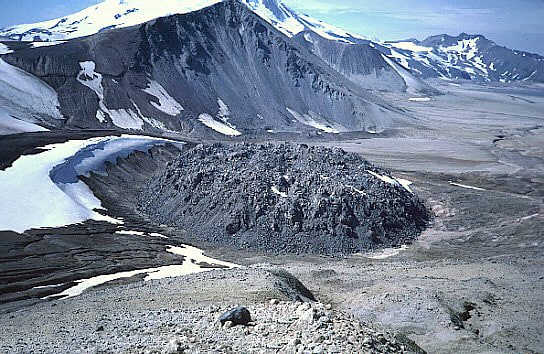
Volcano in Alaska. Novarupta is a volcano that was formed in 1912, located on the Alaska Peninsula on a slope of Trident Volcano in Katmai National Park and Preserve, about 290 miles southwest of Anchorage. Formed during the largest volcanic eruption of the 20th century, Novarupta released 30 times the volume of magma of the 1980 eruption of Mount St. Helens.[1]
Mount Katmai
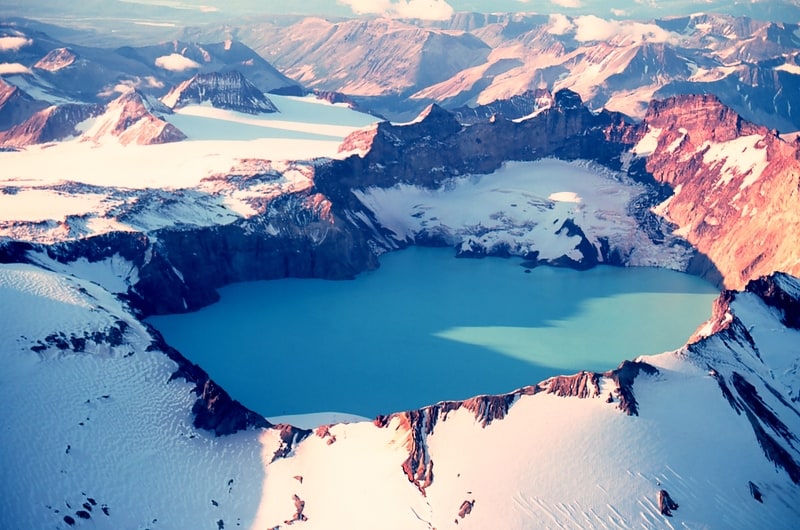
Stratovolcano in Alaska. Mount Katmai is a large stratovolcano on the Alaska Peninsula in southern Alaska, located within Katmai National Park and Preserve. It is about 6.3 miles in diameter with a central lake-filled caldera about two by three miles in size, formed during the Novarupta eruption of 1912. The caldera rim reaches a maximum elevation of 6,716 feet. In 1975 the surface of the crater lake was at an elevation of about 4,220 feet, and the estimated elevation of the caldera floor is about 3,400 ft. The mountain is located in Kodiak Island Borough, very close to its border with Lake and Peninsula Borough.[2]
Valley of Ten Thousand Smokes
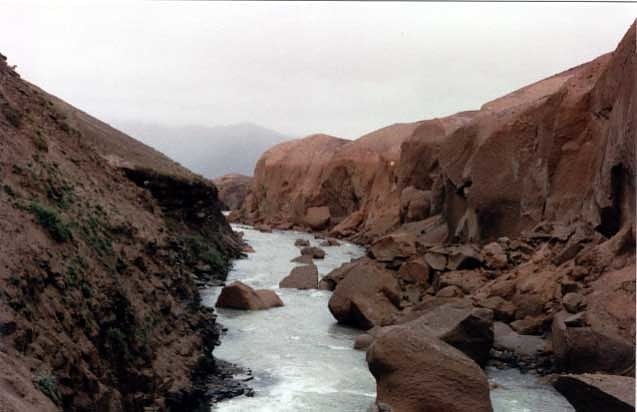
The Valley of Ten Thousand Smokes is a valley within Katmai National Park and Preserve in Alaska which is filled with ash flow from the eruption of Novarupta on June 6–8, 1912. Following the eruption, thousands of fumaroles vented steam from the ash. Robert F. Griggs, who explored the volcano's aftermath for the National Geographic Society in 1916, gave the valley its name, saying that "the whole valley as far as the eye could reach was full of hundreds, no thousands—literally, tens of thousands—of smokes curling up from its fissured floor."
Prior to the eruption, the area now called the Valley of Ten Thousand Smokes was an unremarkable and unnamed portion of the Ukak River valley. Although never permanently inhabited by humans, it served as a pass for the Alutiiq people, as well as animals such as grizzly bears.
The 1912 eruption was the largest eruption by volume in the 20th century, erupting a magma volume of about 13 cubic kilometers (3.1 cu mi). As many as 14 major earthquakes between M s {\displaystyle M_{\text{s}}} 6 to 7, and over 100 earthquakes greater than M s {\displaystyle M_{\text{s}}} 5, resulted from the collapse of the caldera at Mount Katmai and movement within the magmatic plumbing system.
The ash-filled valley covers a 40-square-mile (100 km2) area. The ash can be up to 700 feet (210 m) deep. In places deep canyons have been cut by the River Lethe, allowing observers to see the ash flow strata. Since the ash has cooled, most of the fumaroles are now extinct and despite its name the valley is no longer filled with 'smoke' (i.e. steam). Vegetation still does not grow in the valley. The signs of volcanic activity are still visible on nearby hills.
Katmai's most recent eruption was in 1927, but there have been non-eruptive events as recently as 2003. The Alaska Volcano Observatory still monitors Katmai's activity as part of the Katmai Cluster, where there are five active stratovolcanos within 15 kilometers (9 mi) of Katmai.
Visitors to the valley most commonly arrive via bus along the 20-mile (32 km) road from Brooks Camp, which is the only road in Katmai Park. The valley is a source of creative exploration by photographers and naturalists.[3]
Mount Griggs
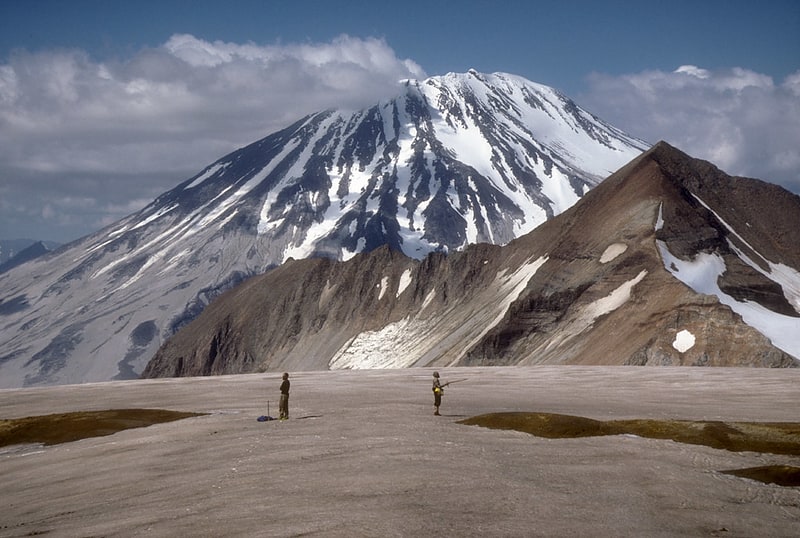
Stratovolcano in Alaska. Mount Griggs, formerly known as Knife Peak Volcano, is a stratovolcano, which lies 10 km behind the volcanic arc defined by other Katmai group volcanoes. Although no historic eruptions have been reported from Mount Griggs, vigorously active fumaroles persist in a summit crater and along the upper southwest flank. The fumaroles on the southwest flank are the hottest, and some of the flank fumaroles can roar so loudly that they can be heard from the valley floor. The slopes of Mount Griggs are heavily mantled by fallout from the 1912 eruption of Novarupta volcano. The summit consists of three concentric craters, the lowest and largest of which contains a recent summit cone topped by two craters. The volume of the volcanic edifice is estimated at about 25 cubic kilometers. Isotopic analysis indicates that the source of Griggs' magma is distinct from the other Katmai volcanoes.
The mountain was named for Dr. Robert Fiske Griggs (1881–1962), botanist, whose explorations of the area, after the eruption of Mount Katmai in 1912, led to the creation of Katmai National Monument by President Woodrow Wilson in 1918.[4]
Mount Mageik
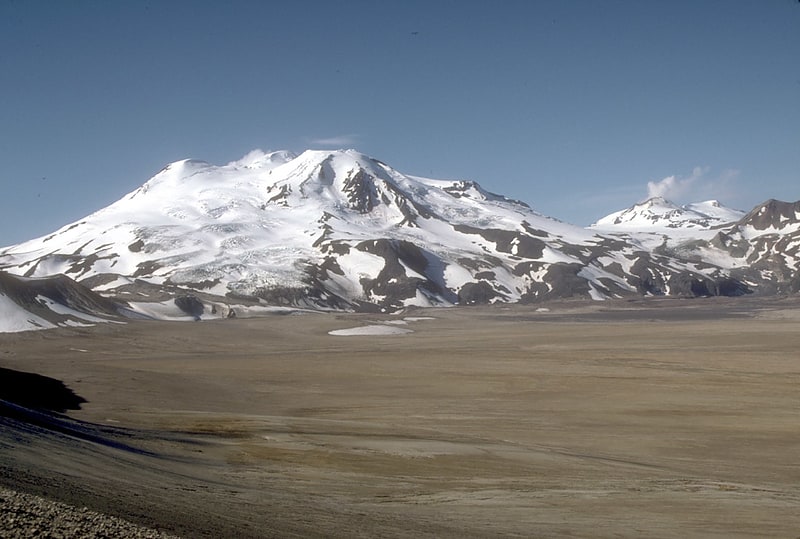
Stratovolcano in Alaska. Mount Mageik is a stratovolcano on the Alaska Peninsula. It has no confirmed historical eruptions, but its youngest eruptive products are apparently Holocene in age. A young crater lies on the northeast flank of the central summit cone, and is the site of vigorous superheated fumarolic activity with prominent sulfur deposits. The volcanic cones are composed of andesite, basaltic andesite and dacite.
The volcano is mantled in ash from the 1912 eruption of Novarupta and from the 1953 eruption of nearby Trident Volcano.[5]
Mount Denison

Stratovolcano in Alaska. Mount Denison is a stratovolcano and one of the highest peaks on the Alaska Peninsula. Discovered in 1923 by Harvard professor Kirtley Fletcher Mather, the mountain was named for the geologist's alma mater, Denison University. The mountain's connection to Denison also include its first climbers: all members of the first two ascent teams as well as the group that attempted in 1977 were either students, alumni, or faculty of the University.
Mount Denison is located at the end of a volcanic chain in a heavily glaciated and very remote section of Katmai National Park. It is possibly the tallest mountain in the national park, though some sources list Mount Griggs as the highest. Mount Griggs, on the other hand, is much more accessible, being next to the Valley of Ten Thousand Smokes, which can be reached via the road from the national park's visitor center.
There is no record of an eruption, but Mount Denison was probably active some time in the last 10,000 years (the Holocene epoch).[6]
Mount Douglas

Stratovolcano in Alaska. Mount Douglas is a stratovolcano located south of Kamishak Bay, near the northeasternmost part of the Alaska Peninsula. It lies in the Katmai National Park and Preserve in Kenai Peninsula Borough. The mountain was officially named in 1906 after nearby Cape Douglas based on a 1904 report by USGS geologist G. C. Martin. The Alaska Volcano Observatory currently rates Douglas as Level of Concern Color Code Not Assigned.
The volcano has a warm and highly acidic crater lake approximately 160 m (525 ft) wide. In 1982, the lake had a temperature of 21 °C and a pH of 1, and temperatures of 114-118°C were measured in 1991. At the north flank of the volcano unglaciated and relatively uneroded lava flows are found. The last eruption is not known, but probably occurred during the Holocene.[7]
Mount Steller
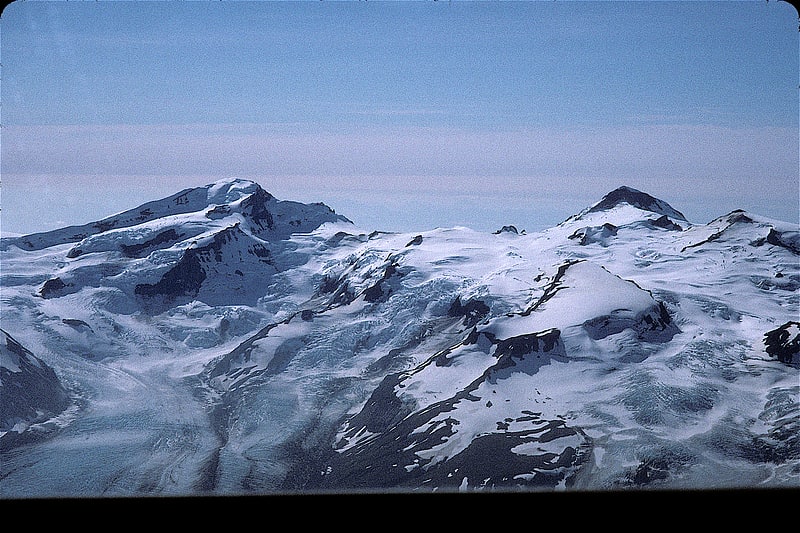
Stratovolcano in Alaska. Mount Steller is a stratovolcano in Katmai National Park in Alaska, United States. It is part of the Aleutian Range and is located on the Alaska Peninsula.
The mountain was presumably named for the naturalist Georg Wilhelm Steller. While evidence is uncertain, the volcano is believed to have erupted during the Holocene epoch.[8]
Mount Kukak
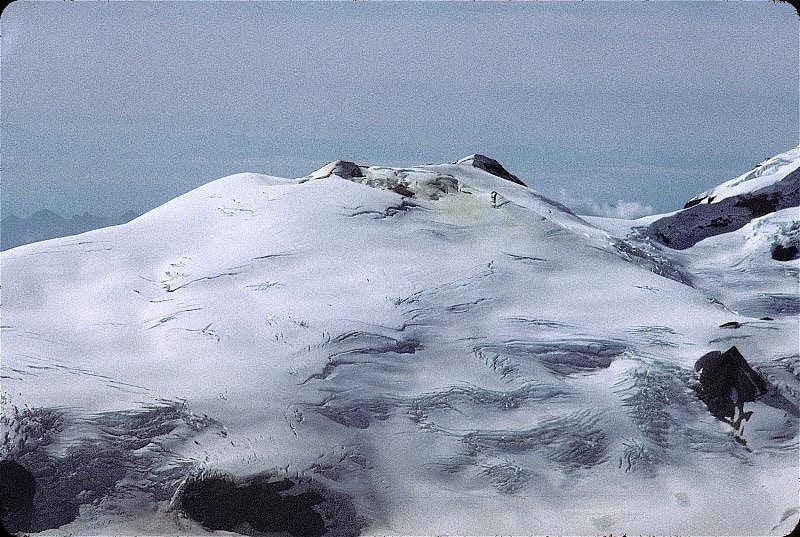
Stratovolcano in Alaska. Mount Kukak is an almost completely ice-covered stratovolcano on the Alaska Peninsula of Alaska, United States. Although the last eruption from Mount Kukak is unknown, it displays vigorous fumarolic activity.[9]
Fourpeaked Mountain
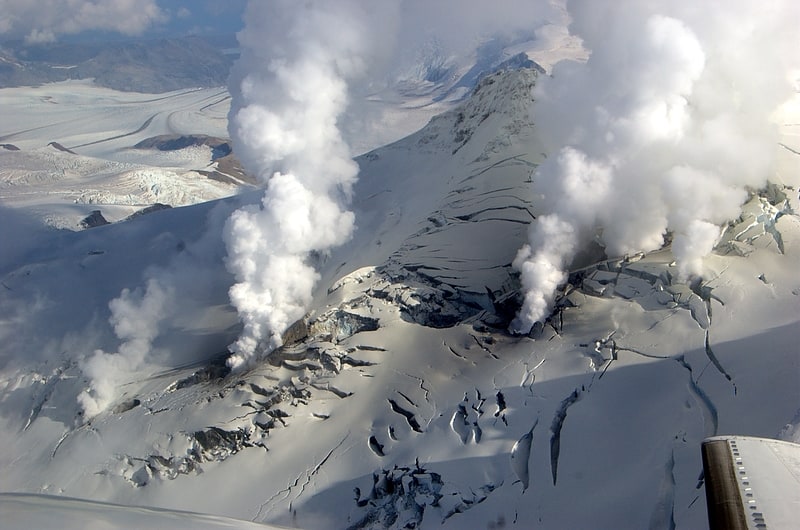
Stratovolcano in Alaska. Fourpeaked Volcano is an active stratovolcano in the U.S. state of Alaska. The Alaska Volcano Observatory rates Fourpeaked Volcano as Aviation Alert Level Green and Volcanic-alert Level Normal. It is nearly completely covered by Fourpeaked Glacier.[10]
Trident Volcano
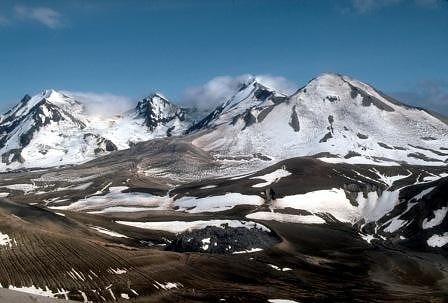
Stratovolcano in Alaska. Trident Volcano is an eroded volcanic complex on the Alaska Peninsula in Katmai National Park, Alaska. Up to 23 domes comprise the complex stratovolcano, with the greatest elevation of 6,115 feet. The most recent major activity produced a 3,599-foot dome in an amphitheater on the southwest flank of the southwest peak. Volcano Novarupta formed on its slopes in the largest volcanic eruption of the 20th century.
According to the United States Geological Survey, the descriptive name, Trident, was given by Robert Fiske Griggs of the National Geographic Society, in 1916, because there were three major peaks. The volcano has been known by several variants of the name. The feature was officially named Mount Trident by the United States Board on Geographic Names in 1928. The board assigned the current name in 1968.[11]